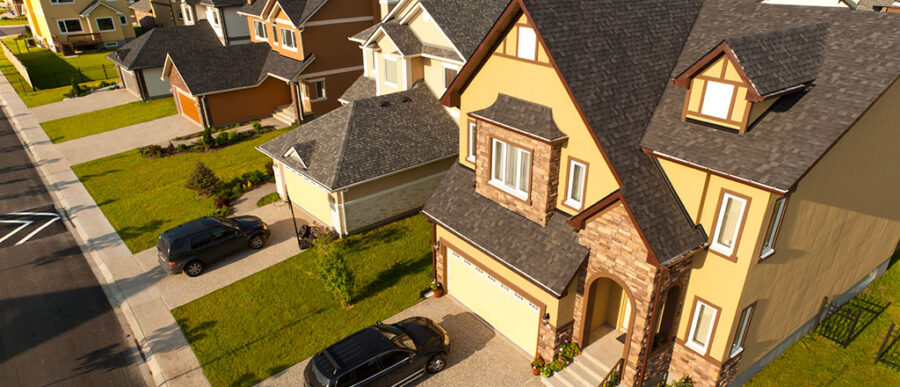When the suburban boom took off in the U.S. in the 1950s, many middle class families moved to those communities as a way to escape the country’s increasingly crowded, dirty and financially strapped cities. But now, as many American cities are gradually being revitalized and the suburbs have expanded outward, some of these former refuges for the middle class are becoming more and more like the places that early suburbanites were trying to escape.
Fueled by the lure of cheap, aging housing stock and low-cost mortgages offered during the height of the housing boom, the rate of those living in suburban poverty has grown substantially over that last two decades. More than 15 million people currently live in poverty in the suburbs, compared with 12.8 million in the cities, according to a book released by the Brookings Institution in May. “Despite the fact that ‘poverty in America’ still conjures images of inner-city slums, the suburbanization of poverty has redrawn the contemporary American landscape,” authors Elizabeth Kneebone and Alan Berube write in Confronting Suburban Poverty in America, noting that the number of poor suburbanites grew by 64% between 2000 and 2011.
What does this growth in suburban poverty mean for the suburbs? What impact will it have on businesses located there? And how will it affect the revitalization of the cities these suburbs surround?
Pushed over the Line
One cause of the uptick in suburban poor is the cyclical effect brought on by the financial crisis, according to Wharton real estate professor Gilles Duranton, who adds that many suburban residents were pushed over the poverty line — defined as $22,314 for a family of four in 2010 — during the economic downturn. “When the economic situation worsens, there is a shift in the poverty rate, but the already poor remain poor,” he notes.
William H. Lucy, a professor of urban planning at the University of Virginia, published Confronting Suburban Decline in 2000 and has been looking at suburban poverty ever since. He says that a decade ago, many typical suburbanites were turning their noses up at the modest housing stock of the close-in suburbs (around 1,100 square feet for the average home built in the 1950s) in favor of newer homes that tended to be double the size of those built 50 or 60 years ago. They moved to the further-out “exurbs” for newer, bigger houses, despite the fact that “the two things these [older] homes have going for them is that they are closer to the urban centers and better built,” Lucy states.
Meanwhile, as the housing stock of the postwar suburbs aged and became less desirable for the typical suburbanite, it also became more affordable. Lower-income people looking for alternatives to apartments moved in. This shift has not necessarily driven down the cost of housing in these older suburbs, but dwellings there are cheaper when compared to those in the city and exurbs. For example, in Allegheny County, a Pittsburgh suburb highlighted in the Brookings book, the poverty rate climbed from 7.9% in 2000 to 12.4% in 2011, according the U.S. Census Bureau, while the median home value rose from $84,200 to $118,200.
Indeed, many of these lower-income individuals were forced out of cities by the increasingly higher rents brought on by the renewed allure of the century-old homes, convenience and amenities in urban areas. “The city is becoming too expensive for many people, but the good news is that the suburbs have quality affordable housing,” Duranton says.
A Push to Share Limited Resources
Therein lies the dilemma for many suburban municipalities: They are losing higher-income individuals to the cities, thereby shrinking the tax base and, subsequently, the number and quality of services they can afford to offer when it comes to areas like education, health care and transportation, according to Wharton real estate professor Jessie Handbury. And unlike cities, which can often raise additional tax revenue from businesses and tourism, most suburban municipalities lack other ways to make money. “The issue is that with the growing number of suburban poor, the taxes to support programs to help them might not be there,” she adds.
Indeed, these municipalities often don’t have the services that are traditionally used more by lower income individuals. “Many low income families in the suburbs — whether recent arrivals or long-time residents — are living in safer neighborhoods with access to higher-quality schools than their counterparts in poor inner-city neighborhoods…. But suburban life can also mean great isolation from transportation, social services, employment and community support,” Kneebone and Berube write in their book.
The demographics of the suburban poor look a lot like the urban poor when it comes to age, marital status, employment and education, according to the Brookings Institution. Where they diverge is that those in the suburbs are more likely to own a home (36.4% vs. 19.7%) and are more likely to be white (43.7% vs. 23.8%).
And while federal safety nets like food stamps and subsidized housing are available to the urban and suburban poor alike, many job training, health care and nonprofit services are more prevalent in cities. Kneebone and Berube suggest that this need should drive municipalities to work together to provide better services and share the limited resources they do have. Two collaborations highlighted in their book are the Chicago Southland Housing and Community Development Collaborative, which includes 23 municipalities, and the West Cook County Housing Collaborative, which represents five different communities. Both of these were organized — and then secured funds from various sources — to help with community development as well as help to rehabilitate older rental housing and foreclosed homes.
Duranton says that municipalities should make it a priority to provide more frequent and expansive public transportation. An example of this is a decision by the District of Columbia, Virginia and Maryland to jointly set up that area’s Metro system three decades ago. “Transportation is the key issue,” Duranton says. “But the density in most North American suburbs is so low that it’s hard to justify even bus service.”
He adds that all suburban governments — particularly those in the further-out suburbs — need to become more welcoming to all income levels and stop creating laws that put a minimum on housing lot sizes or make it difficult to build multi-family housing.
Walmart’s Small-store Format
The poor are being drawn to the suburbs not just by more affordable housing, but also by the lower cost of goods, thanks to big-box retailers like Walmart and Target. According to Handbury, the increase in poverty in the suburbs is not a deterrent to these larger retailers but rather an encouragement, because low-income individuals are more likely to frequent this type of retailer for a greater number of their needs, rather than use the traditional department stores and supermarkets that dominated the suburbs three decades ago.
As for those traditional suburban mall stores, Handbury says that many of the companies that own them are catering to the changing demographics of their customer base by creating offshoots with different price points and then locating them in areas where there will likely be more demand. For example, she notes, Gap has its namesake mid-price flagship, but has also spawned the lower-cost Old Navy chain and the higher-end Banana Republic. And the lower-cost options are proving to be the most successful. For Gap, Old Navy North America sales were up 8% in the fourth quarter of 2012 compared to the year before, while Gap North America sales were up just 4%, and Banana Republic sales were up just 3%.
But Wharton real estate professor Fernando Ferreira does not expect big-box retailers to begin expanding into city centers, hoping to attract business from the wealthier individuals who have been moving in. Instead, he predicts that more specialty stores and higher-end chains will be drawn to the city. “It’s hard for the big retailers. They have a business model, and for low costs, they need cheap land and rent. Cities are really expensive,” Ferreira says. “So for a store like Walmart to go into the city, it would really have to downsize.”
Walmart has been trying to do that by introducing a small-store format called Walmart Express into center city markets. After dealing with the contentious issue of fair wages, it finally set up a handful of stores in Chicago. But political tension has caused the company to abandon expansion plans in Boston and New York, and Walmart is facing a similar fair wage battle in Washington, D.C., even as new stores are already under construction.
As for the industries outside of retail, Duranton does not think the shift in poverty will affect where businesses look to expand or relocate. He notes that over the past 50 years, many businesses — from manufacturing to technology — have been moving headquarters to the suburbs because of tax breaks and cheaper real estate. An increase in poverty in those areas will not result in much change. “I think the jobs that would have gone [to the suburbs] have already gone, and there is not much left,” Duranton says. “And most don’t want to move back into the city because real estate is [so expensive].”
The Very Rich versus the Very Poor
During the initial rise of the suburbs following World War II, the downtowns of many big cities were reduced to rows of empty storefronts and scenes of blight. But many cities have won back a growing upper-income audience, thanks to empty nesters looking to downsize and young adults who are drawn to the convenience of living in an urban area. “Thirty years ago, you got married right out of college and moved to the suburbs,” Duranton notes. “Now, people are waiting for 10 years after graduation to settle down [in the suburbs]. So there is a much bigger demographic group of grownups with some education and some means choosing central cities and contributing to gentrification.”
Still, there is a large portion of very poor people living in the city centers, particularly as city governments in recent years have tried to protect and maintain the few low-income housing options that do exist. In fact, the poverty rate in the cities is still considerably higher — 21% compared with 11% in the suburbs. “Poverty did not trade one location for the other, but instead affected both cities and suburbs as it grew,” Kneebone and Berube write in their book.
Consequently, cities are becoming more divided between rich and poor. However, U.S. cities still have a long way to go until they become like many of their South American or European counterparts — where the very rich live in the city center and the very poor live in the close-in suburbs. What may help prevent this trend, according to some experts, is the lack of widespread public transportation in the United States, forcing the poorest of the poor who cannot afford a car to stay in the cities. Still, governments and residents need to be aware of this trend, accommodating all income levels in all locales.
This picture — of the very rich living in the city center while the very poor are relegated to the outskirts — “may be extremely unlikely, and it’s different for every city,” Lucy says. “But the question is, how far and how fast are we going in that direction?”



